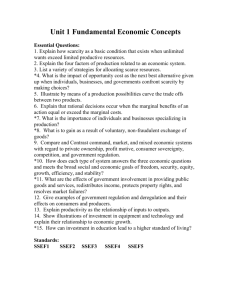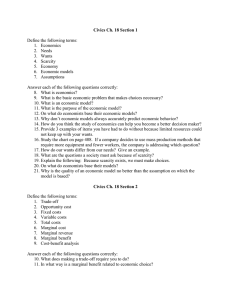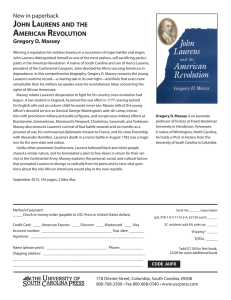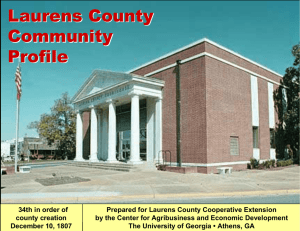Economics Pacing Guide - Laurens County Schools
advertisement
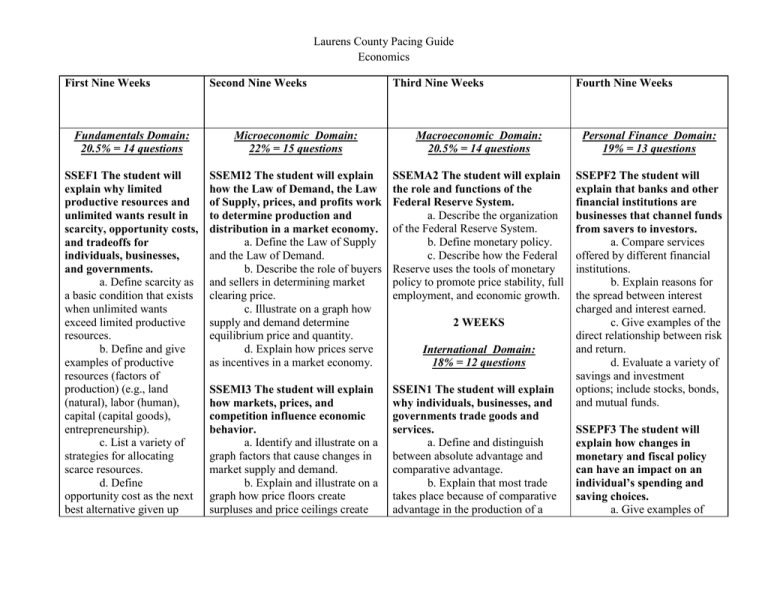
Laurens County Pacing Guide Economics First Nine Weeks Second Nine Weeks Third Nine Weeks Fourth Nine Weeks Fundamentals Domain: 20.5% = 14 questions Microeconomic Domain: 22% = 15 questions Macroeconomic Domain: 20.5% = 14 questions Personal Finance Domain: 19% = 13 questions SSEF1 The student will explain why limited productive resources and unlimited wants result in scarcity, opportunity costs, and tradeoffs for individuals, businesses, and governments. a. Define scarcity as a basic condition that exists when unlimited wants exceed limited productive resources. b. Define and give examples of productive resources (factors of production) (e.g., land (natural), labor (human), capital (capital goods), entrepreneurship). c. List a variety of strategies for allocating scarce resources. d. Define opportunity cost as the next best alternative given up SSEMI2 The student will explain how the Law of Demand, the Law of Supply, prices, and profits work to determine production and distribution in a market economy. a. Define the Law of Supply and the Law of Demand. b. Describe the role of buyers and sellers in determining market clearing price. c. Illustrate on a graph how supply and demand determine equilibrium price and quantity. d. Explain how prices serve as incentives in a market economy. SSEMA2 The student will explain the role and functions of the Federal Reserve System. a. Describe the organization of the Federal Reserve System. b. Define monetary policy. c. Describe how the Federal Reserve uses the tools of monetary policy to promote price stability, full employment, and economic growth. SSEMI3 The student will explain how markets, prices, and competition influence economic behavior. a. Identify and illustrate on a graph factors that cause changes in market supply and demand. b. Explain and illustrate on a graph how price floors create surpluses and price ceilings create SSEIN1 The student will explain why individuals, businesses, and governments trade goods and services. a. Define and distinguish between absolute advantage and comparative advantage. b. Explain that most trade takes place because of comparative advantage in the production of a SSEPF2 The student will explain that banks and other financial institutions are businesses that channel funds from savers to investors. a. Compare services offered by different financial institutions. b. Explain reasons for the spread between interest charged and interest earned. c. Give examples of the direct relationship between risk and return. d. Evaluate a variety of savings and investment options; include stocks, bonds, and mutual funds. 2 WEEKS International Domain: 18% = 12 questions SSEPF3 The student will explain how changes in monetary and fiscal policy can have an impact on an individual’s spending and saving choices. a. Give examples of Laurens County Pacing Guide Economics when individuals, businesses, and governments confront scarcity by making choices. SSEF2 The student will give examples of how rational decision making entails comparing the marginal benefits and the marginal costs of an action. a. Illustrate by means of a production possibilities curve the trade offs between two options. b. Explain that rational decisions occur when the marginal benefits of an action equal or exceed the marginal costs. SSEF3 The student will explain how specialization and voluntary exchange between buyers and sellers increase the satisfaction of both parties. a. Give examples of how individuals and businesses specialize. b. Explain that both parties gain as a result of shortages. c. Define price elasticity of demand and supply. SSEMI4 The student will explain the organization and role of business and analyze the four types of market structures in the U.S. economy. a. Compare and contrast three forms of business organization—sole proprietorship, partnership, and corporation. b. Explain the role of profit as an incentive for entrepreneurs. c. Identify the basic characteristics of monopoly, oligopoly, monopolistic competition, and pure competition. 6 WEEKS Macroeconomic Domain: 20.5% = 14 questions SSEMA1 The student will illustrate the means by which economic activity is measured. a. Explain that overall levels of income, employment, and prices are determined by the spending and production decisions of households, businesses, government, and net exports. good or service. c. Explain the difference between balance of trade and balance of payments. SSEIN2 The student will explain why countries sometimes erect trade barriers and sometimes advocate free trade. a. Define trade barriers as tariffs, quotas, embargoes, standards, and subsidies. b. Identify costs and benefits of trade barriers over time. c. List specific examples of trade barriers. d. List specific examples of trading blocks such as the EU, NAFTA, and ASEAN. e. Evaluate arguments for and against free trade. who benefits and who loses from inflation. b. Define progressive, regressive, and proportional taxes. c. Explain how an increase in sales tax affects different income groups. SSEPF4 The student will evaluate the costs and benefits of using credit. a. List factors that affect credit worthiness. b. Compare interest rates on loans and credit cards from different institutions. c. Explain the difference between simple and compound interest rates. SSEPF5 The student will SSEIN3 The student will explain describe how insurance and how changes in exchange rates can other risk-management have an impact on the purchasing strategies protect against power of individuals in the United financial loss. a. List various types of States and in other countries. a. Define exchange rate as insurance such as automobile, the price of one nation’s currency in health, life, disability, and terms of another nation’s currency. property. b. Locate information on b. Explain the costs and exchange rates. benefits associated with c. Interpret exchange rate different types of insurance; Laurens County Pacing Guide Economics voluntary, non-fraudulent exchange. b. Define Gross Domestic Product (GDP), economic growth, unemployment, Consumer Price Index (CPI), inflation, stagflation, SSEF4 The student will and aggregate supply and aggregate compare and contrast different economic systems demand. c. Explain how economic and explain how they growth, inflation, and answer the three basic unemployment are calculated. economic questions of d. Identify structural, what to produce, how to produce, and for whom to cyclical, and frictional unemployment. produce. a. Compare e. Define the stages of the command, market, and business cycle, include peak, mixed economic systems contraction, trough, recovery, with regard to private expansion as well as recession and ownership, profit motive, depression. consumer sovereignty, f. Describe the difference competition, and between the national debt and government regulation. government deficits. b. Evaluate how well each type of system answers SSEMA3 The student will explain the three economic how the government uses fiscal questions and meets the policy to promote price stability, broad social and economic full employment, and economic goals of freedom, security, growth. equity, growth, efficiency, a. Define fiscal policy. and stability. b. Explain the government’s taxing and spending decisions. SSEF5 The student will describe the roles of 3 WEEKS government in a market economy. tables. d. Explain why, when exchange rates change, some groups benefit and others lose. 6 WEEKS Personal Finance Domain: 19% = 13 questions SSEPF1 The student will apply rational decision making to personal spending and saving choices. a. Explain that people respond to positive and negative incentives in predictable ways. b. Use a rational decision making model to select one option over another. c. Create a savings or financial investment plan for a future goal. 1 WEEK include deductibles, premiums, shared liability, and asset protection. SSEPF6 The student will describe how the earnings of workers are determined in the marketplace. a. Identify skills that are required to be successful in the workplace. b. Explain the significance of investment in education, training, and skill development. 9 WEEKS Laurens County Pacing Guide Economics a. Explain why government provides public goods and services, redistributes income, protects property rights, and resolves market failures. b. Give examples of government regulation and deregulation and their effects on consumers and producers. SSEF6 The student will explain how productivity, economic growth, and future standards of living are influenced by investment in factories, machinery, new technology, and the health, education, and training of people. a. Define productivity as the relationship of inputs to outputs. b. Give illustrations of investment in equipment and technology and explain their relationship to economic growth. c. Give examples of how investment in education Laurens County Pacing Guide Economics can lead to a higher standard of living. 8 WEEKS Microeconomic Domain: 22% = 15 questions SSEMI1 The student will describe how households, businesses, and governments are interdependent and interact through flows of goods, services, and money. a. Illustrate by means of a circular flow diagram, the Product market; the Resource (factor) market; the real flow of goods and services between and among businesses, households, and government; and the flow of money. b. Explain the role of money as a medium of exchange and how it facilitates exchange. 1 WEEK Laurens County Pacing Guide Economics
